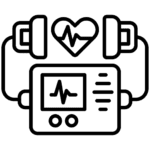Hospital beds have evolved significantly over the years. The basic purpose of these beds is to provide comfort and facilitate the treatment of patients. However, modern hospital beds, especially the five-function beds, offer much more than just a place to rest. These beds are equipped with various advanced features that not only ensure a higher level of patient comfort but also play a crucial role in improving patient care.
In this article, we’ll explore the key functionalities of a five-function bed and discuss how each feature enhances patient care. Additionally, we will cover important considerations when purchasing such a bed, followed by a section of frequently asked questions (FAQs) to help you make an informed decision.
What is a Five-Function Bed?
A five-function bed is a specialized hospital bed designed to provide the utmost comfort and support to patients. These beds are equipped with five adjustable features that can be customized according to the patient’s needs. The functionalities typically include adjustments for:
- Head Elevation
- Foot Elevation
- Height Adjustment
- Trendelenburg and Reverse Trendelenburg
- Tilting (Fowler’s Position)
These adjustable positions allow healthcare providers to ensure the best possible positioning for patients based on their medical conditions, while also enhancing comfort and promoting better outcomes.
1. Head Elevation
The first key feature of the five-function bed is the ability to elevate the head. The head section of the bed can be raised to a variety of angles, which can have a significant impact on patient care. This functionality is particularly beneficial for patients suffering from conditions such as respiratory distress, sleep apnea, or heart problems.
How Head Elevation Improves Patient Care:
- Eases Breathing: Raising the head of the bed helps improve lung expansion and increases airflow, which can alleviate shortness of breath, especially for patients with conditions like COPD or asthma.
- Prevents Aspiration: Patients who are at risk of aspiration (the inhalation of food, liquids, or saliva into the lungs) benefit from the ability to adjust the head. This position reduces the risk of aspiration pneumonia.
- Improves Digestion: Elevating the head can help with the digestion process, particularly after surgery or in patients with gastrointestinal issues, such as acid reflux.
- Relieves Pressure on the Spine: It can also relieve pressure on the spine and promote comfort for patients who spend long periods in bed.
Example:
For a patient recovering from surgery or dealing with difficulty breathing, a properly elevated head can significantly ease their symptoms and improve their overall recovery.
2. Foot Elevation
The ability to elevate the foot section of the bed provides significant benefits for patients dealing with lower extremity issues, such as swelling, poor circulation, or injuries. This feature is especially important for patients who need relief from leg pain, edema (swelling), or those recovering from surgery or trauma in the lower limbs.
How Foot Elevation Improves Patient Care:
- Reduces Swelling: Elevating the legs encourages venous return, which reduces swelling in the feet and legs. This is particularly helpful for patients with conditions like deep vein thrombosis (DVT) or edema.
- Improves Circulation: Elevation helps improve blood flow in the lower limbs, which can be especially beneficial for patients with poor circulation, diabetes, or those at risk for ulcers or blood clots.
- Alleviates Pain: Foot elevation can provide relief from discomfort associated with conditions like arthritis, injuries, or post-surgical recovery.
- Enhances Comfort: For bedridden patients, foot elevation enhances comfort by reducing pressure on the legs and allowing for a more relaxed posture.
Example:
A patient recovering from knee surgery or someone with peripheral artery disease will find foot elevation essential in managing their symptoms and promoting faster healing.
3. Height Adjustment
The ability to adjust the overall height of the bed plays a critical role in patient care. The height adjustment allows caregivers to easily position the bed at a comfortable working height for tasks such as feeding, administering medication, or conducting physical therapy. It also helps patients transition in and out of bed more easily, improving their independence.
How Height Adjustment Improves Patient Care:
- Improved Access for Caregivers: Caregivers benefit from height-adjustable beds as they can easily adjust the bed to a comfortable level, reducing strain on their backs and improving efficiency during care activities.
- Facilitates Patient Mobility: Height adjustment makes it easier for patients to get in and out of bed. It can be adjusted to allow the patient to stand or sit with minimal assistance, promoting independence.
- Enhances Comfort and Safety: Adjusting the height of the bed ensures that patients can stay in a comfortable position throughout the day, preventing pressure sores and facilitating relaxation.
- Promotes Better Posture: The ability to raise or lower the bed to a proper height helps patients maintain better posture, particularly for those with back problems or postural issues.
Example:
A patient who is able to raise the bed to a suitable height for getting in and out without assistance experiences increased independence and reduces the need for constant help from caregivers.
4. Trendelenburg and Reverse Trendelenburg
Trendelenburg and Reverse Trendelenburg are positions that tilt the bed in different directions. Trendelenburg involves tilting the bed so that the patient’s head is lowered and the feet are elevated, while the reverse position raises the head and lowers the feet.
How Trendelenburg and Reverse Trendelenburg Improve Patient Care:
- Trendelenburg: This position is typically used for patients experiencing shock, hypotension (low blood pressure), or during certain surgical procedures. It helps increase blood flow to the upper body and head, which can stabilize blood pressure and improve oxygenation.
- Reverse Trendelenburg: This position is used to facilitate breathing and reduce pressure on the abdomen. It is beneficial for patients with respiratory conditions, gastrointestinal issues, or those who need to be positioned to prevent aspiration or reflux.
- Enhances Surgical Recovery: Both positions are used in post-operative recovery to improve circulation, ease breathing, and reduce the risk of complications.
Example:
A post-surgical patient or someone with low blood pressure may benefit from the Trendelenburg position to improve circulation. In contrast, a patient recovering from abdominal surgery may find the reverse Trendelenburg position more comfortable.
5. Tilting (Fowler’s Position)
Fowler’s position involves raising the head and sometimes the knees while keeping the patient’s legs slightly bent. This position is widely used in clinical settings to help with respiratory function, comfort, and patient positioning during recovery.
How Fowler’s Position Improves Patient Care:
- Improves Respiratory Function: Elevating the head in Fowler’s position helps with lung expansion, which is particularly beneficial for patients with respiratory issues or those recovering from surgery.
- Prevents Pressure Ulcers: The slight elevation of the legs and body in Fowler’s position helps reduce the risk of pressure ulcers by redistributing pressure points on the body.
- Facilitates Eating and Drinking: Fowler’s position makes it easier for patients to eat and drink comfortably while in bed, which is particularly useful for those who are immobile or bedridden.
- Reduces the Risk of Aspiration: By elevating the head and chest, Fowler’s position helps prevent aspiration, especially in patients who have swallowing difficulties or are at risk of aspiration pneumonia.
Example:
For a patient who has undergone abdominal surgery or is suffering from a respiratory condition like pneumonia, positioning them in Fowler’s position can provide relief, improve lung function, and promote better digestion.
How Five-Function Beds Enhance Patient Care
Each of these five functions—head elevation, foot elevation, height adjustment, Trendelenburg/reverse Trendelenburg, and tilting (Fowler’s position)—are crucial in improving patient care. Together, these functionalities allow caregivers to tailor the bed positioning to the individual needs of the patient, which can:
- Promote Better Recovery: Proper positioning can help prevent complications such as pressure sores, improve circulation, and enhance comfort, all of which contribute to faster recovery times.
- Facilitate Breathing and Comfort: Elevating the head, using Trendelenburg or reverse Trendelenburg positions, and tilting the body help with breathing and prevent aspiration.
- Improve Independence: Height adjustment and tilting functions allow patients to move with more ease, promoting independence and reducing the need for assistance from caregivers.
- Reduce the Risk of Complications: By regularly adjusting the bed for comfort and safety, caregivers can prevent conditions such as pressure ulcers, muscle stiffness, and circulatory problems.
FAQs About Five-Function Beds
1. What are the five functions of a hospital bed?
A five-function bed includes adjustments for head elevation, foot elevation, height adjustment, Trendelenburg/reverse Trendelenburg positions, and Fowler’s position.
2. How do these beds improve patient care?
These beds enhance patient care by providing customizable positions to improve comfort, circulation, breathing, and prevent complications like pressure ulcers and aspiration.
3. Can a five-function bed be used at home?
Yes, five-function beds are often used in home healthcare settings, especially for patients with chronic conditions, post-surgery recovery, or those who require long-term care.
4. Are five-function beds easy to adjust?
Most five-function beds are user-friendly, with easy-to-use controls for both patients and caregivers. Some models feature electric adjustments, while others may have manual controls.
5. How does the Trendelenburg position help patients?
The Trendelenburg position is used to increase blood flow to the upper body and brain, making it useful for patients with low blood pressure or those experiencing shock.
6. Is the Fowler’s position beneficial for breathing problems?
Yes, Fowler’s position helps with lung expansion and can improve oxygenation, making it ideal for patients with respiratory issues or those recovering from surgery.
 Hospital Furniture
Hospital Furniture Medical Devices
Medical Devices MSR Products
MSR Products Office Furniture
Office Furniture